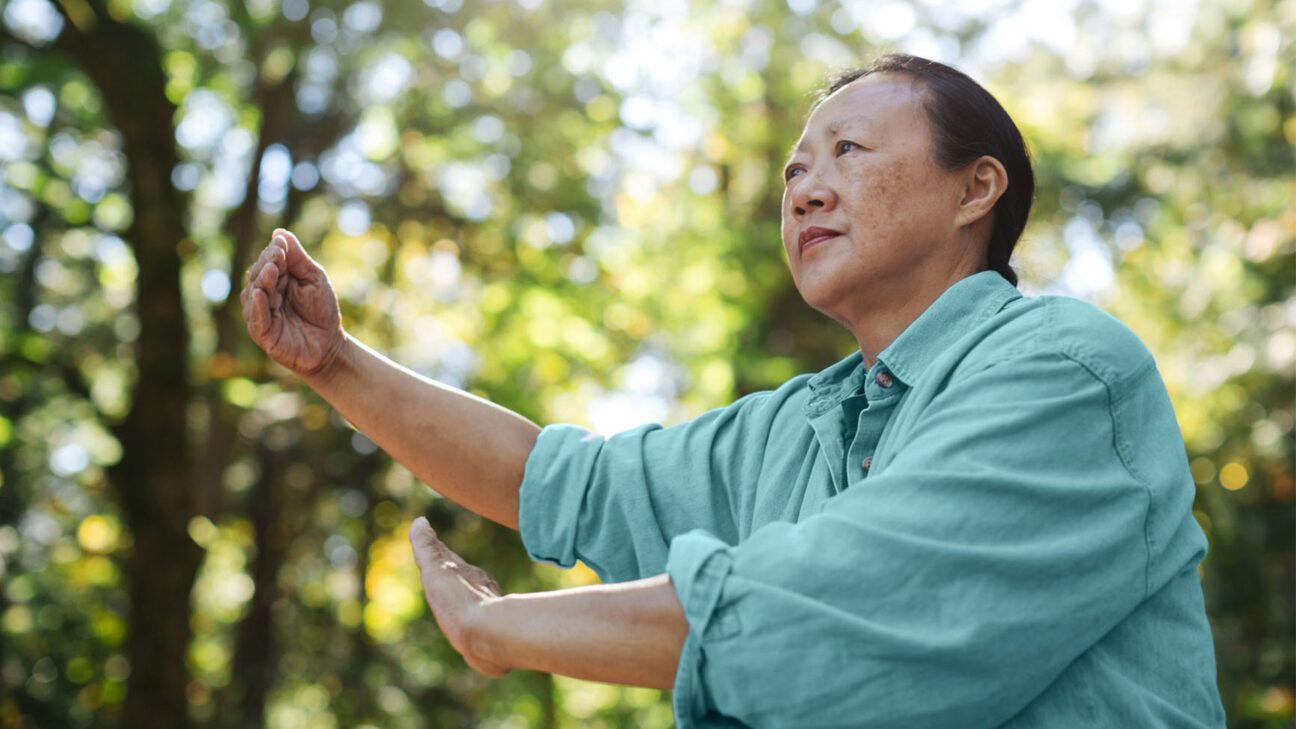
- A new study finds that tai chi may help people who have Parkinson’s disease.
- There is no cure for Parkinson’s disease, and while the available medications ease symptoms, they don’t appear to slow disease progression.
- Physical therapy aimed at training parts of the brain to compensate for loss of movement can improve gait and balance in people with Parkinson’s disease.
Tai chi, the Chinese martial art practice that involves a series of slow movements and postures, may alleviate symptoms of Parkinson’s disease and slow disease progression, new research suggests.
The study, published in the Journal of Neurology, Neurosurgery & Psychiatry on October 24, found that cognitive function declined slower in people diagnosed with Parkinson’s who practiced tai chi than those who did not.
There is no cure for Parkinson’s disease, and while the available medications ease symptoms, they don’t appear to slow disease progression.
Regular exercise like tai chi may help control symptoms and delay progression of the disease, the researchers say.
According to Dr. Molly Cincotta, an assistant professor of clinical neurology at the Lewis Katz School of Medicine at Temple University and a neurologist at Temple University Hospital, prior evidence suggests physical activity is one of the only interventions that seems to slow Parkinson’s disease.
Additionally, physical therapy aimed at training parts of the brain to compensate for loss of movement can improve gait and balance in people with Parkinson’s disease.
“I suspect that tai chi incorporates both of these interventions, as it involves regular physical activity as well as mindful movement,” Cincotta, who was not involved in the study, told Healthline.
To understand how tai chi impacts symptoms and complications of Parkinson’s disease, researchers recruited 330 individuals with Parkinson’s disease beginning in January of 2016. The average observation time for the study was 4.3 years.
The participants were split into two groups: 143 practiced tai chi twice a week for 1 hour, and 187 received standard care but did not practice tai chi.
The research team assessed disease progression in all patients at the start of the study and again in November 2019, October 2020, and June 2021.
They looked at subjects’ autonomic nervous system function (including urinary function and bowel movements), the extent of movement, mood, sleep quality, and cognition.
They also tracked complications related to the disease, such as:
- dyskinesia (involuntary movement)
- dystonia (abnormal muscle tone)
- responsiveness to medications
- cognitive impairment
- hallucinations
- restless leg syndrome (RLS)
The team found that disease progression was slower in the group that practiced tai chi.
Those who practiced tai chi saw improvements in gait and balance, sleep, and cognitive function and experienced less complications.
For example, 1.4% of those in the tai chi group experienced dyskinesia compared to 7.5% of those who did not practice tai chi.
In addition, 2.8% of people who practice tai chi developed mild cognitive impairment (MCI) compared to 9.6% in the group that didn’t do tai chi.
Medication use was also higher in the group that did not practice tai chi.
In 2019, over 83% of those who did not practice tai chi needed to increase their medication compared to 71% of those who regularly did Tai Chi.
In 2020, over 96% of people who didn’t practice tai chi needed to increase their medication compared to 87% of those who did tai chi.
“This study suggests that regular [tai chi] practice may be beneficial for motor function, sleep, cognition and overall quality of life in patients with idiopathic Parkinson’s disease,” said Cincotta.
Parkinson’s is a neurodegenerative disorder mainly characterized by the loss of cells in the brain that produce dopamine, a neurotransmitter involved in many body functions, including:
- mood regulation
- cognition
- motor function
“When these cells are lost, and there is less dopamine in the brain, it is similar to trying to drive with the parking brake on. You can have movement, but it is stiff, slow, and often jerky,” said Cincotta.
Over time, the lack of dopamine can cause tremors, altered facial expressions and shuffling gait, and anxiety, depression, or apathy, Cincotta added.
The disease may also cause increased inflammation, and the more inflammatory substances there are in the body, the more severe symptoms tend to be, evidence suggests.
Medication is the mainstay treatment for Parkinson’s disease.
These drugs, which focus on boosting diminished levels of dopamine, help relieve symptoms, but they don’t appear to have a significant impact on disease progression.
In addition, the effectiveness of these drugs may decline over the course of the illness.
According to Dr. Ihtsham ul Haq, the chief of the Division of Movement Disorders at the University of Miami Health System, exercise is the only way to slow down Parkinson’s disease progression.
“Tai chi is an excellent way to obtain this benefit but is certainly not the only way,” he said.
Researchers are exploring why exercise has this effect on Parkinson’s disease.
It’s suspected that regular physical activity may improve circulatory health, reduce inflammation, or change cellular function like protein accumulation and mitochondrial function, said Haq.
Tai chi, in particular, may help people stay socially connected, which has a positive effect on cognition, Cincotta added.
According to Haq, it’s unclear if certain types of exercise are better than others.
“No one has found a limit to the effect, so people with Parkinson’s disease should exercise in whatever form they find fulfilling as frequently as they find comfortable,” Haq said.
New research suggests that tai chi may alleviate symptoms of Parkinson’s disease and slow disease progression.
Medication is the mainstay treatment for Parkinson’s; however, the available drugs do not appear to delay disease progression.
Much evidence suggests that exercise, like tai chi, seems to be the only intervention that can successfully slow disease progression.
